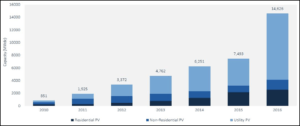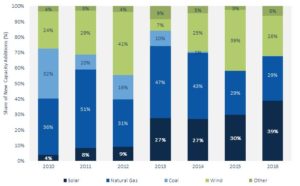SunPower: Dark Clouds Over Sunny Future

The growth of the solar industry is under threat because of Tariffs being proposed on imported solar cells, which had contributed greatly towards getting cost of solar energy down to a level conducive for mass adoption.
Solar energy adoption has seen a massive uptick in USA, with the installed capacity doubling last year to 14626 MW1.
1Source: GTM Research
Solar dominated new electricity generating capacity (39%) in USA1.
1Source: GTM Research
This growth has been predominantly supported by declining cost of solar energy2.
2Source: EnergySage Solar Marketplace
However, in this booming market an unexpected threat has come from isolationistic trade policies for the second largest solar company in USA, SunPower. Two American solar manufacturers have petitioned the International trade commission by invoking Section 201 of Federal Trade Law (under which the President of USA has broad authority to impose tariffs for protecting a domestic industry3) by claiming that the flood of subsidized imports of Photovoltaic cells from china has forced many US manufacturers of solar cells into bankruptcy.
The trade commission has recommended (to the President) tariffs of upto 35% on solar equipment containing crystalline silicon photovoltaic (CSPV) cells purchased from abroad. With such a tariff solar energy will become more expensive and its adoption in USA will reduce4.
4Source: GTM research
As a player in this industry, the shrinkage of market will affect SunPower’s future cash flows and stock price. SunPower is a California based pioneer, manufacturer and installer of high technology solar panels. However, its manufacturing plants are located in Philippines, Malaysia, Mexico, & France. Sun power’s gross margin has been reducing year on year5. Tariffs would increase their cost of revenue and significantly impinge on their profitability.
5Source: SunPower Annual report 2016
Furthermore, this tariff is applicable only to CSPV cells and hence doesn’t affect SunPower’s main competitor, First Solar, which uses a different technology (cadmium telluride). This would effectively create a monopoly like industry structure.
Currently, the management of SunPower is opposing the Tariffs with assistance from Solar Energy Industries Association (SEIA) and recommending to the ITC and the President that Tariffs would be harmful for the industry at large. Their arguments are on the following lines:
- Loss of jobs: Manufacturing jobs, which is what the Tariff aims to protect, are a smaller part of the overall labor in the industry6. Shrinkage of Solar energy market due to Tariffs would impact the other 75% of the skilled jobs that the industry has created, which were projected to grow at a fast rate7.
6Source: The Solar Foundation Report
7Source: Bureau of Labor Statistics
- Product Differentiation & R&D innovation: SunPower is an innovator in Solar cell research and makes Integrated Back Contact cells which have highest efficiency (25%). They do not compete in the low cost low efficiency market as the petitioners do, that is flooded by Chinese products. Hence, they have asked to exclude the superior IBC technology they use, which is a result of American innovation and research spend, such that they are treated on equal footing with competitor First Solar. They argue that not doing so would significantly impact American competitiveness in the race for solar technology superiority7.
- Economics 101: Tariffs would also impact ancillary industries like steel, glass and aluminum which had received a shot in the arm due to solar adoption. According to SunPower the case for Tariffs in a healthy industry cannot be made. They point out that in 2002 similar stiff tariffs was imposed on imported steel, to protect the US steel industry, which led to the loss of up to 200,000 domestic jobs and an estimated $4 billion in wages within a year and were subsequently withdrawn8.
SunPower has currently built up a sizeable inventory of solar panels as a hedge, to assure their ongoing contracts of uninterrupted supply for next 6 months9.
As a plan B, if the tariffs come to effect, they could request for an extension or grace period before Tariffs are applied, to prepare for its impact on business. Subsequently they may have to choose their target markets more stringently considering their comparative costs would rise significantly. They will need to absorb the tariffs inorder to maintain prices in market, which could be compensated for by reduced Marketing, R&D spend or further operational efficiency.
In the medium term, they might need to look at setting up manufacturing facilities in USA and explore bringing in high levels of automation to offset increased labor costs. Furthermore, they would need to explore if overseas manufacturing equipment can be shifted to USA. SunPower could also explore buying any of the bankrupt American manufacturers. This of course depends on whether SunPower’s technology can be manufactured in traditional solar cell manufacturing plants.
Expansion into global markets would help hedge against such trade policy surprises.
While sudden tariffs seem unfair on incumbent players who have built a technological advantage over long years, job protectionism is subject to political opinion. But what about the carbon footprint of importing panels from abroad?
WORD COUNT: (797)
Endnotes:
1 Mike Munsell, “US Solar market grows 95%in 2016, smashes record”, feb 2017 [ https://www.greentechmedia.com/articles/read/us-solar-market-grows-95-in-2016-smashes-records#gs.iK8H1Q0 ], accessed Nov 2017.
2 Sara Matasci, “How Much does the average solar panel installation cost in the US?” energysage.com, September 16,2017,[http://news.energysage.com/how-much-does-the-average-solar-panel-installation-cost-in-the-u-s/ ] , accessed November 2017.
3 United States International Trade commission [https://www.usitc.gov/press_room/us_safeguard.html ]
3 Ana Swanson, “To Protect U.S. Solar Manufacturing, Trade Body Recommends Limits on Imports”, New York Times,Oct 31 2017,[https://www.nytimes.com/2017/10/31/business/solar-industry-import-tariffs.html] , accessed Nov 2017.
4 MJ Shiao, Cory honeyman, Jade jones, “U.S. Solar Outlook Under Section 201: Supply and Demand Impacts of Tariffs at $0.10/W Increments” , Greentechmedia.com,Oct2017, [https://www.greentechmedia.com/research/report/us-solar-outlook-under-section-201-supply-and-demand-impacts-of-tariffs#gs.NJysLQA], accessed Nov2017.
5 Sunpower, 2016 Annual Report, pg 53.
6 Avery Palmer, “Solar Accounts for 1in 50 jobs in USA”, thesolarfoundation.org, Feb2017, [https://www.thesolarfoundation.org/solar-accounts-1-50-new-u-s-jobs-2016/ ], accessed Nov 2017.
7 Tom Werner, “Sunpower CEO Tom Werner’s Oct 3 ITC testimony”, Sunpower.com (blog), Oct 2017 [https://us.sunpower.com/blog/2017/10/03/sunpower-ceo-testifies-us-international-trade-commission/],accessed Nov 2017.
8 Tom Werner, “Opportunity for white house to make the right call”, Sunpower.com (blog) , Nov 2017 [ https://us.sunpower.com/blog/2017/10/31/opportunity-white-house-make-right-call-solar/ ], accessed Nov 2017.
9 Interview with Sunpower EVP & GM, Martin DeBono, Nov 2017.










Thanks for the article / keeping the world safe Jason Bourne! I couldn’t agree more with the assertion that the loss of manufacturing jobs pales in comparison to the potential loss of other jobs in the solar industry, but it seems like our current political climate places a premium on manufacturing jobs when considering outsourcing. Claiming a tariff will help keep American manufacturing alive, especially manufacturing that has likely been subsidized by the government at some point (given the prior clean energy breaks these companies often receive), is usually a winning proposition on the national stage.
I’m also a bit confused by the financial numbers from SunPower over the past 5 years. You’ve established that the industry is growing rapidly and installed capacity doubled last year, but SunPower’s revenue is down significantly since 2014. Has there been something else specific to SunPower that has caused its decline while in a booming industry? You mentioned that they currently have the superior technology, is that not something that is appreciated by the industry? Has the market moved to prefer the low-cost low-efficiency products that are made by competitors? If so, there’s a chance SunPower has larger problems than the impending tariffs.
Jason Bourne,
I agree that tariffs are unfair to incumbent players but let’s not forget the American consumer. Why should Americans pay more for solar panels when cheaper international options exist? It would be interesting to see a comparison of the net economic impact on the nation from losing two US solar manufacturers vs. energy generation from cheaper (albeit internationally subsidized) solar panels. I think you should incorporate public education of economics into the recommended action plan. Only the people losing jobs will likely make noise about the issue since the impact on the nation is amortized.
I also like your question about the carbon footprint of importing panels. Do the gains from installing more cheaper panels from abroad outweigh the import footprint especially if cheaper panels drive adoption rates? Could the tariffs also cause a shift out of solar into less renewable resources especially with lower natural gas prices? More worrisome is that the tariffs will reduce competition for US manufacturers and slow innovation.
Mr. Bourne,
I’m not convinced that this will make the solar energy market shrink. It instead may shift the demand to First Solar whose different technology you cited is cheaper in the US. Also, the growing demand in the US would cause newer entrants/SunPower to produce in the US to compete with First Solar. While this policy seems to hurt SunPower in the short-term, I don’t think solar energy itself is at risk, nor the loss of jobs of solar energy installers. It definitely makes sense for them to ask for a grace period to adapt to this shift. They should either diversify their country base to mitigate impact of policy changes or diversify the product base to lower operational costs. Apart from their declining gross margin % in the past few years which is troubling, the future of SunPower (and other solar companies) is bright.
As an aside, happy to see we’ve got 29% more mathematicians in the world.
Mr. Bourne, interesting and informative article. I agree that the political environment can lead to decisions that are sub-optimal for business and workers in both the near and long term. This appears to be one such situation. I would be curious how significant the cost differences are for SunPower and how many vendors the company has sourced. I also would focus on solutions elsewhere in the operating model. Given the declining cost of solar energy and subsequent increase in adoption, I am surprised to see such declining gross margins for a firm that has a technological advantage. Are they “getting paid” for having a stronger offering or is the value being captured by another party?
Thanks for an engaging read Jason! The article touches on a very important and relevant topic, given the current climate of protectionism. The above two comments also bring in diverse perspectives and interesting leads for further probing the true nature of SunPower’s problems.
I wanted to add that the imposition of internal tariffs by the USA government is especially strange given their opposition in the WTO to other countries adopting protectionist policies [1] and the fact that a USA based company is equally impacted by this move. In the above case, India lost its case to exert domestic content requirements in the WTO. The interesting aspect is that India has now sued the USA in the WTO against protectionism in their domestic (state) markets [2].
Both these cases highlight the importance of global agreements and institutions as protectors of long-term thinking and stability on issues of public policy. These institutions allow for a measure of protection against populist positioning and short-termism by localized political actors.
[1] http://www.worldwatch.org/another-solar-trade-dispute-united-states-files-wto-complaint-against-india
[2] https://www.reuters.com/article/us-india-usa-trade/india-takes-u-s-renewable-energy-dispute-to-the-wto-idUSKCN11I165